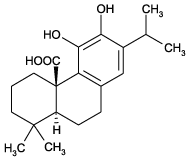Naturally occurring phenolic compound with antioxidant properties. Inhibits lipid peroxidation induced by NADH or NADPH oxidation. Peroxisome proliferator-activated receptor γ (PPARγ) activator. Anti-inflammatory. Antimicrobial.
Product Details
| Formula: | C20H28O4 |
| |
| MW: | 332.4 |
| |
| Source: | Isolated from Rosmarinus officinalis. |
| |
| CAS: | 3650-09-7 |
| |
| Purity: | ≥95% (HPLC) |
| |
| Appearance: | Yellow powder. |
| |
| Shipping: | Blue Ice |
| |
| Long Term Storage: | -20°C |
| |
| Handling: | Protect from light. |
| |
| Regulatory Status: | RUO - Research Use Only |
| |
Please mouse over
Product Literature References
Cancer-selective cytotoxic Ca2+ overload in acute myeloid leukemia cells and attenuation of disease progression in mice by synergistically acting polyphenols curcumin and carnosic acid: S. Pesakhov, et al.; Oncotarget
7, 31847 (2016),
Abstract;
Full Text
Carnosic acid slows photoreceptor degeneration in the Pde6b(rd10) mouse model of retinitis pigmentosa: K. Kang, et al.; Sci. Rep.
6, 22632 (2016),
Application(s): Injection into mice,
Abstract;
Full Text
Nrf2 activation ameliorates cytotoxic effects of arsenic trioxide in acute promyelocytic leukemia cells through increased glutathione levels and arsenic efflux from cells: S. Nishimoto, et al.; Toxicol. Appl. Pharmacol.
305, 161 (2016),
Application(s): Nuclear transcription factor activation,
Abstract;
Carnosic acid protects photoreceptor against degeneration in Pde6rd10 mice through activating Nrf2 pathway: K. Kang, et al.; Acta Pharm. Sin. B (2015), Application(s): Intraperitoneal injection to Pde6rd10 mice,
The anti-cancer effects of carotenoids and other phytonutrients resides in their combined activity: K. Linnewiel-Hermoni, et al.; Arch. Biochem. Biophys.
572, 28 (2015),
Application(s): Cell Culture,
Abstract;
Potentiation of antimicrobial activity of aminoglycosides by carnosol from Salvia officinalis: K. Horiuchi, et al.; Biol. Pharm. Bull.
30, 287 (2007),
Abstract;
Carnosic acid and carnosol, phenolic diterpene compounds of the labiate herbs rosemary and sage, are activators of the human peroxisome proliferator-activated receptor gamma: O. Rau, et al.; Planta Med.
72, 881 (2006),
Abstract;
Chemiluminescence determination of the in vivo and in vitro antioxidant activity of RoseOx and carnosic acid: A.I. Kuzmenko, et al.; J. Photochem. Photobiol. B
48, 63 (1999),
Abstract;
Inhibition of lipid peroxidation and superoxide generation by diterpenoids from Rosmarinus officinalis: H. Haraguchi, et al.; Planta Med.
61, 333 (1995),
Abstract;
Rosemary components inhibit benzo[a]pyrene-induced genotoxicity in human bronchial cells: E.A. Offord, et al.; Carcinogenesis
16, 2057 (1995),
Abstract;
Radical intermediates and antioxidants: an ESR study of radicals formed on carnosic acid in the presence of oxidized lipids: M. Geoffroy, et al.; Free Radic. Res.
21, 247 (1994),
Abstract;
Antioxidant and pro-oxidant properties of active rosemary constituents: carnosol and carnosic acid: O.I. Aruoma, et al.; Xenobiotica
22, 257 (1992),
Abstract;
Antioxidative constituents of Rosmarinus officinalis and Salvia officinalis. II. Isolation of carnosic acid and formation of other phenolic diterpenes: K. Schwarz & W. Ternes; Z. Lebensm. Unters. Forsch.
195, 99 (1992),
Abstract;












